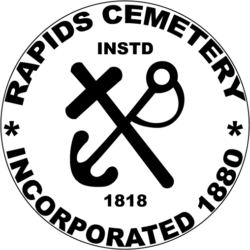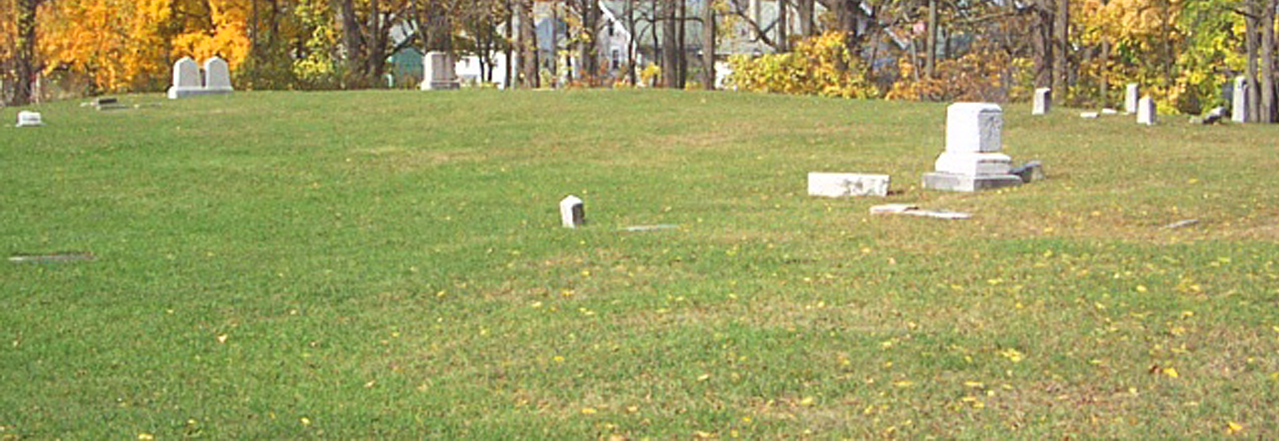Rapids Cemetery’s history begins over two hundred years ago. It was incorporated in 1818 but land acquisition from the Wadsworth family of Geneseo took place several years earlier. Rapids Cemetery was originally within the town borders of Gates. The City of Rochester annexed this land in 1874 as it expanded outwards with trolley service.
Rapids Cemetery is named after the nearby pioneer Rapids settlement located at today’s Brooks Landing (Brooks Avenue at Genesee Street). Early records indicate that the cemetery is about 1.5 acres. The accessible flat cemetery surface area today is roughly the size of a football field. The northern slope needs further reclamation.
The placement of the cemetery was geologically decided. Melting glaciers during the last Ice Age deposited boulders in the nearby Genesee River creating cataracts with non-navigable shallow fast-flowing waters. The elevation of the deposited soil, called a glacial moraine, provided good soil drainage in a formerly marshy area. It is possibly the highest location in southwest Rochester.
In its prime, the cemetery featured many more headstones and other artifacts related to roadways, burial plots, and maintenance. The current trees did not exist. The timeline provides a quick overview of the history of Rapids Cemetery.
Rapids Settlement
Of the earliest residents of Rapids settlement, some were farmers but many were canal boatmen for the Genesee Valley Canal that ran parallel to the Genesee River at this site. Others were teamsters who off-loaded and transported river cargo by wagon to the early downtown Rochester settlement.
The rich wheat-producing farmland in southwest Rochester also supported extensive floral and fruit tree nurseries. An apple orchard bordered the cemetery in its early days. At the time of the Erie Canal relocation, circa 1920, there was crude temporary worker housing in the area. The orchards surrounding the cemetery gave way to housing developments in the early decades of the Twentieth Century.
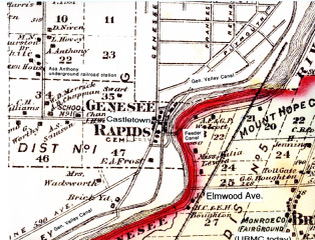
Burials
A cemetery map created by Isaac Loomis and updated in 1881 lists individual or family burial plots. Surveys done generations ago by the Daughters of the American Revolution add further detail. The true number of burials is unknown due to limited surviving records of actual burials. Current genealogical research continues and can be viewed on the Burials page.
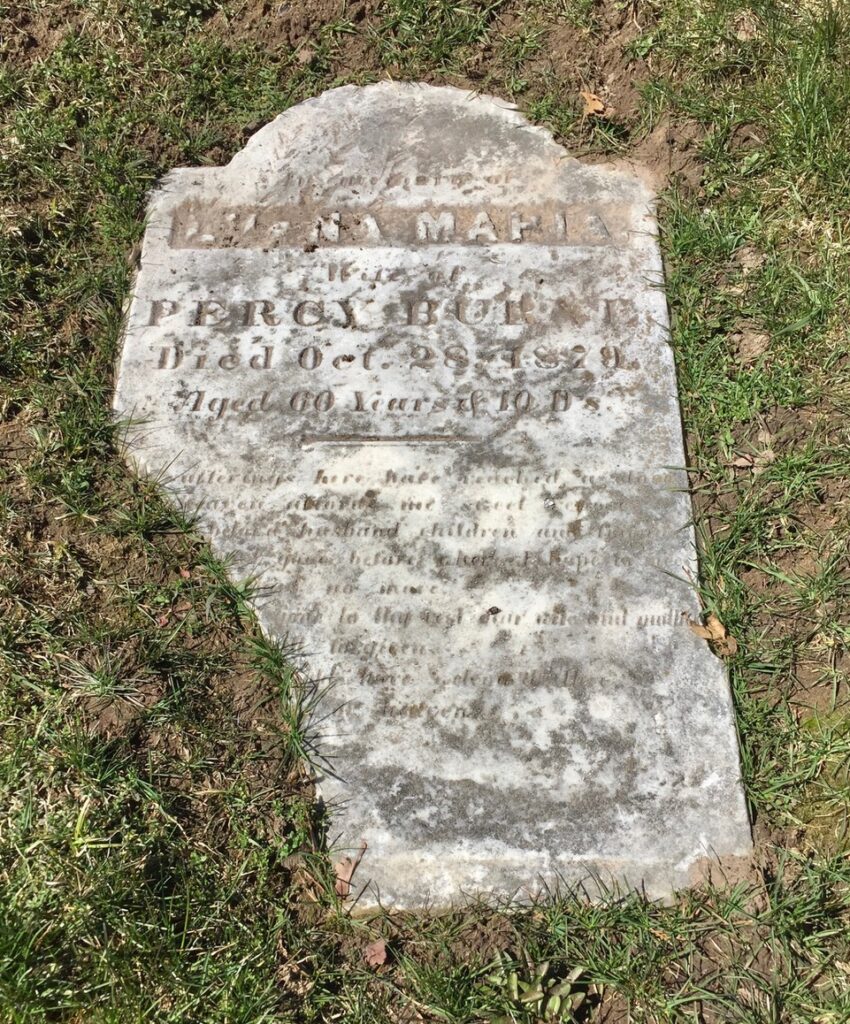
The cemetery has a mix of civilian and military burials. Veterans from the Revolutionary War, War of 1812, Civil War, and possibly the Spanish-American War are interred here. A local hero of the War of 1812, Captain Daniel Loomis is buried here along with his extended family. Civil War era Rochesterians joined the 13th New York Volunteer Infantry, 108th NYVI and 140th NYVI. The 108th and 140th NYVI trained at Camp FitzJohn Porter about a mile north of Rapids Cemetery along the Genesee River near Flint Street. Veterans from other regiments are buried here also. All the Civil War gravestones at Rapids Cemetery are Government-Issued replacements added in the 1960s at the time of the Civil War Centennial.
The civilians laid to rest at Rapids Cemetery include laborers, barrel-makers (coopers), inn and tavern keepers, carpenters, blacksmiths, seamstresses, domestic servants, washerwomen, architects, a chairmaker, a whip-maker, a police constable, a lawyer, and even a Justice of the Peace.
Several founding members of the Genesee Baptist Church are also buried here. Originally known as Rapids Baptist Church, it began as a mission to minister to the needs of the Rapids settlement. The area was considered rowdy with several taverns and there was occasional conflict among the residents. For a closer look at this area, check out the Genesee Baptist Church Historiette.
Rapids Cemetery has a Potter’s Field that occupies the southwest border along the sidewalk. Many residents of Rapids settlement were very poor, and many had no family locally. They were likely buried in a simple fabric shroud with no casket or headstone.
Rapids settlement was populated with young migrants from elsewhere in the US and immigrants to America fleeing harsh economic conditions and wars. Many died young from disease with no family to remember them. They are listed as “stranger” on the Loomis plot map.
Diseases claimed many lives. Today’s medicines, antibiotics, and sanitation were not available then. Epidemics like cholera and malaria (known as “Genesee Fever”) caused death. Many young women died due to complications at or after childbirth.
The headstone of Frederick Peiffer placed at Rapids Cemetery is a mystery. The Spanish-American War veteran is actually buried at Mt. Hope Cemetery. The headstone at Rapids Cemetery is a duplicate that lacks key dates. Several other headstone pieces have migrated somewhat from their original positions.
The last known burial was William L. King in 1941. The cemetery had become overgrown and neglected around 1910, so many neighbors were surprised at that time that a cemetery even existed there.
Decline of Cemetery
Despite Rapids settlement being older than the Rochesterville settlement of 1811, the location of the Erie Canal aqueduct in the 1820s at Nathaniel Rochester’s One Hundred Acres plot drew economic development and population growth two miles northward. The citizens who founded the private cemetery corporation had moved or passed away by 1910. Neither the County nor the City assumed cemetery ownership. The cemetery grew significantly wild for over one hundred years. The City of Rochester now controls and maintains the grounds.
Restoration Efforts
Back in 2015, the 19th Ward Community Association responded to requests from local veterans groups to restore the cemetery. Hundreds of neighborhood, college, civic, and youth group members have contributed since then with practical assistance from the City of Rochester. Efforts are ongoing.
The Rapids Cemetery Restoration Committee, formed in 2015, is comprised of the 19th Ward History & Archives group, City of Rochester Historian, City Department of Environmental Services, neighbors and local veterans. These members research, consult, plan and undertake the cemetery restoration processes. A Canadian researcher with family ties to Rapids Cemetery, Eileen McElroy, has conducted extensive scholarly research.
The 19th Ward Community Association’s History & Archives Group worked over a 3-year period with Rochester Institute of Technology undergraduate teams in order to create this self-guided tour. Under the direction of Professors Stephen Zilora and Mike Zink, the members of the team whose project was selected for implementation were: Clayton Brimm, Brett Phillips, Jonathan Aurit, Robert O’Connell, Sven Kopun, and Niko Jugovac. The project was recently handed over in 2020 to a different team of RIT undergrad students including: Marissa Burkland, Andrew England, and Michele Fensken.
There are several issues that have been faced in maintaining a record of burials at Rapids Cemetery. Many of the Rapids settlement residents were poor and could not afford headstones. Some grave markers, over time, had sunk into the ground. Many were vandalized. Some were removed to create a playing field by neighborhood youth.
A professional Ground-Penetrating Radar (GPR) flat terrain scan performed in 2016 identified only one headstone. Careful manual soil-probing since 2016 uncovered about ten subsurface headstones. The City Historian is considering the professional restoration of some of the toppled or broken grave markers.
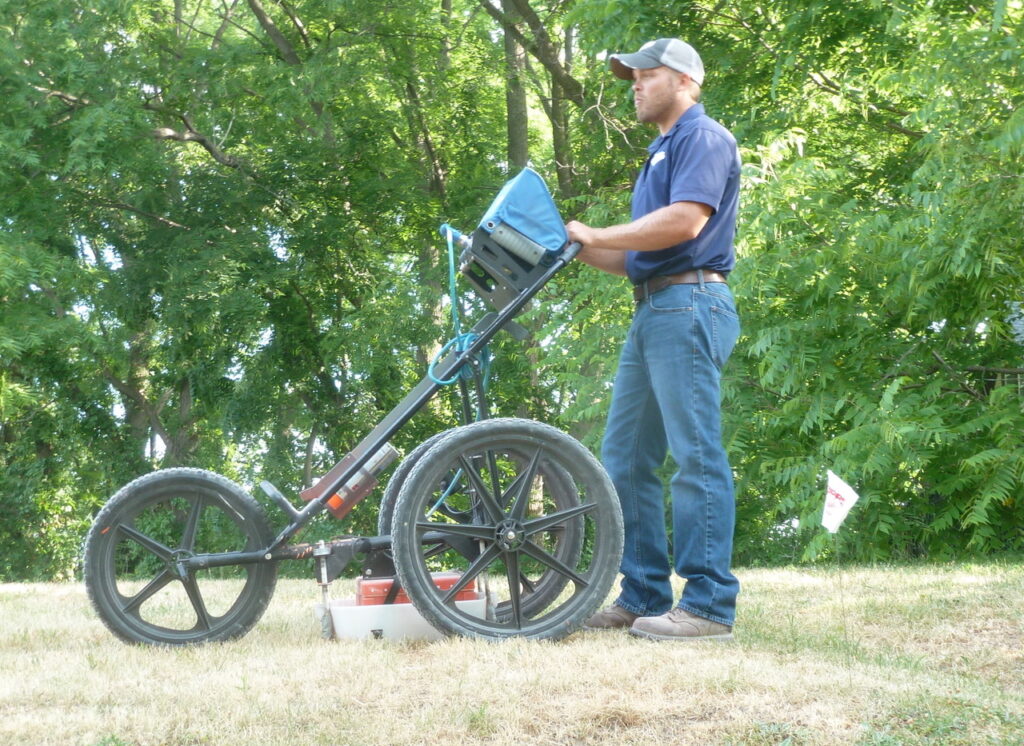
The Rapids Cemetery Restoration Committee has reclaimed the previously overgrown land at the site. Weeds, vines, and wild “volunteer” vegetation covered the sloped areas. Wild growth was eradicated by manual effort. Scouting groups restored lawn surfaces by covering the bare weed-free earth with layers of cardboard, mulch, and topsoil to block root regrowth.
Toppled undisturbed trees created the conditions for the establishment of wild black raspberry bushes in an area called the “food forest.” These heritage organic specimens are now cultivated. Youth volunteers harvest the fruit which is donated to the local St. Peter’s Kitchen.
Nearby History
The names of some persons buried at Rapids Cemetery are memorialized as street names. Some such names include Brooks, Thurston, and Ballintine.
Rapids Cemetery is about a mile from the bicycle trailhead junction in Genesee Valley Park that links the Erie Canalway, Genesee Valley Greenway and the City of Rochester’s Riverway Trails. To transfer from the Riverway Bicycle trail to Rapids Cemetery, make a detour westward from the Riverway bicycle trail at the Brooks Landing pedestrian bridge. (Brooks Avenue and South Plymouth Avenue). Proceed one-third mile southward along Genesee Street to 90 Congress Avenue.
Susan B. Anthony lived nearby at her father’s family farm near today’s Brooks Avenue and Genesee Park Blvd. She lived here during her Temperance, Abolition and Women’s Rights periods from 1840 until 1865. She then moved to Madison Street in Rochester.
There are identified Underground Railroad locations in southwest Rochester including the Rhoda DaGarmo home just a few hundred yards away from Rapids Cemetery. Abolitionist Frederick Douglass visited the Anthony family farm. Nineteenth Ward resident Asa Anthony, a distant cousin of Susan, helped freedom-seekers find refuge. Further research is needed.
Despite a connection to the area, neither Frederick Douglas nor Susan B. Anthony was buried at Rapids Cemetery. Each has a separate burial plot in the Victorian-style municipal Mt. Hope Cemetery noted for its design by the famed Olmsted landscape architecture family.
